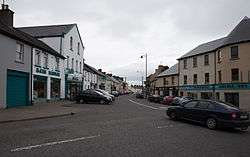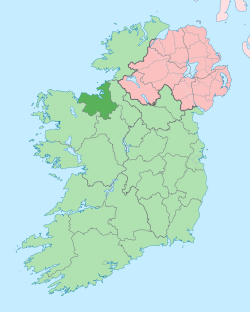Collooney
Collooney or Coloony (Irish: Cúil Mhuine, meaning "nook of the thicket"[2]) is a town in County Sligo, Ireland.
Collooney Cúil Mhuine | |
|---|---|
Town | |
 Main Street | |
 Collooney Location in Ireland | |
| Coordinates: 54°10′59″N 8°29′31″W | |
| Country | Ireland |
| Province | Connacht |
| County | County Sligo |
| Elevation | 62 m (203 ft) |
| Population (2016)[1] | 1,610 |
| Time zone | UTC+0 (WET) |
| • Summer (DST) | UTC-1 (IST (WEST)) |
| Irish Grid Reference | G674261 |
Toponymy
Collooney is thought to derive from Irish: Cúil Mhuine, meaning "nook of the thicket".[2] Reverend Terrence O'Rorke has previously also suggested Culmaine as Collooney is designed in such works as the Four Masters, Dudley M'Firlis and O'Flaherty's "Chrorographical description of West Connaught"; and he further suggests "Angle of the Whirlpool" from the confluence of the Uncion and Owenmore as the most likely origin of the name.[3] The settlement was also at times previously termed Cashel, KillinBridge or even Cowlowney.[4]
History
During the Irish Rebellion of 1798, a battle took place outside the town in which a combined French and Irish force defeated British troops from the Sligo garrison. Known as the Battle of Collooney (or Battle of Carricknagat), this conflict is commemorated by the Teeling Monument outside the town - named for a member of the United Irishmen who was involved in the battle.[5]
In the 18th century and bleach mill was built locally by Charles O'Hara in an effort to increase industry in the Sligo area. O'Hara brought in weavers and bleachers from the north to settle in the Collooney area.[6] The mill finally closed in 1956.[7] The mill was also used at certain times in its history for the production of carbide, a mixture of coal, coke and lime.[8]
Geography

The main part of the town lies to south west of the Owenmore River which joins the Unshin River just to the north of the town to form the Ballysadare River.
Transport
Collooney is located just off the N4 (Dublin to Sligo) and N17 (Sligo to Galway) roads, having been bypassed twice, by the N4 in 1998, and the N17 in 1992, and is the meeting point of both roads.
The town was a significant railway centre, with no less than three railway stations. In addition to the one remaining Collooney railway station, opened on 3 December 1862,[9] (on the railway from Dublin to Sligo) there was a station on the line to Claremorris (The Western Railway Corridor) and on the Sligo, Leitrim and Northern Counties Railway line to Enniskillen.
See also
- Connolly Park
- List of towns in the Republic of Ireland
References
- "Population and Actual and Percentage Change 2011 to 2016". Central Statistics Office. Retrieved 3 December 2017.
- "Cúil Mhuine/Collooney". Placenames Database of Ireland. Government of Ireland - Department of Arts, Heritage and the Gaeltacht and Dublin City University. Archived from the original on 5 December 2017. Retrieved 3 December 2017.
- O'Rorke (1878), p. 52.
- O'Rorke (1878), p. 53.
- "Bartholomew Teeling". breifne.ie. Breifne Tourism. Archived from the original on 28 September 2007.
- Bartlett, Thomas (1982). "The O'Haras of Annaghmore c. 1600—c. 1800: Survival and Revival". Irish Economic and Social History. Sage Publications Ltd. 9: 43–44. JSTOR 24337261.
- McTerran, John (2012). "Lost with the Titanic" (PDF). The Corran Herald. Ballymote Heritage Group (45): 38. Archived (PDF) from the original on 24 December 2016. Retrieved 13 November 2019.
- Kilcoyne (2012), p. 33.
- "Collooney station" (PDF). Railscot - Irish Railways. Archived (PDF) from the original on 17 February 2011. Retrieved 7 September 2007.
- Kilcoyne, James P (2012). "Carbide Story" (PDF). The Corran Herald. Ballymote Heritage Group (45): 33.CS1 maint: ref=harv (link)
- O'Rorke, Terence (1878). History, Antiquities, and Present State of the Parishes of Ballysadare and Kilvarnet, in the County of Sligo. Dublin: James Duffy and Co. OCLC 1045989729.CS1 maint: ref=harv (link)
- O'Rorke, Terence (1900). The History of Sligo: Town and Country. 2. Dublin: James Duffy and Co. OCLC 367563777. OL 24786532M.CS1 maint: ref=harv (link)
Further reading
- Wood-Martin, William Gregory (1889). History of Sligo, County and Town, from the Accessession of James I. to the revolution of 1688. Dublin: Hoggs, Figgis, and Co. OCLC 1046595954.CS1 maint: ref=harv (link)
External links
| Wikimedia Commons has media related to Collooney. |
- Collooney Methodist Church (archived)
